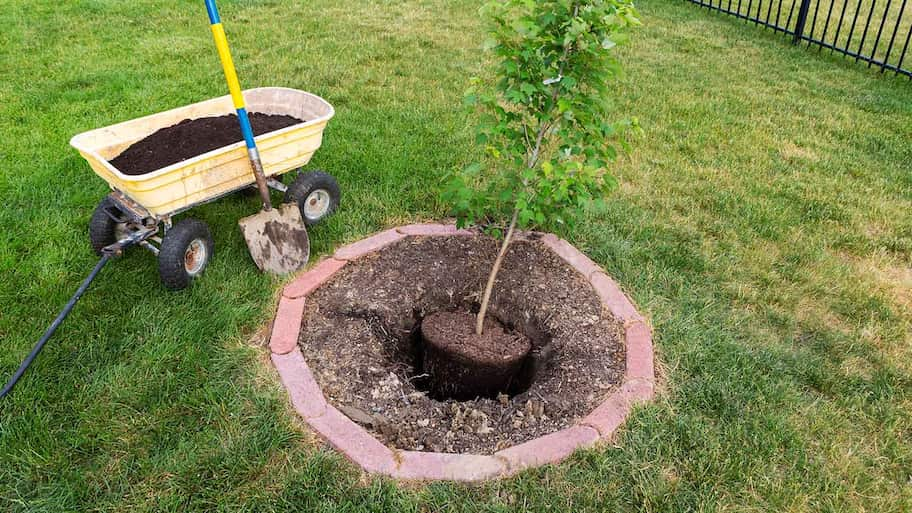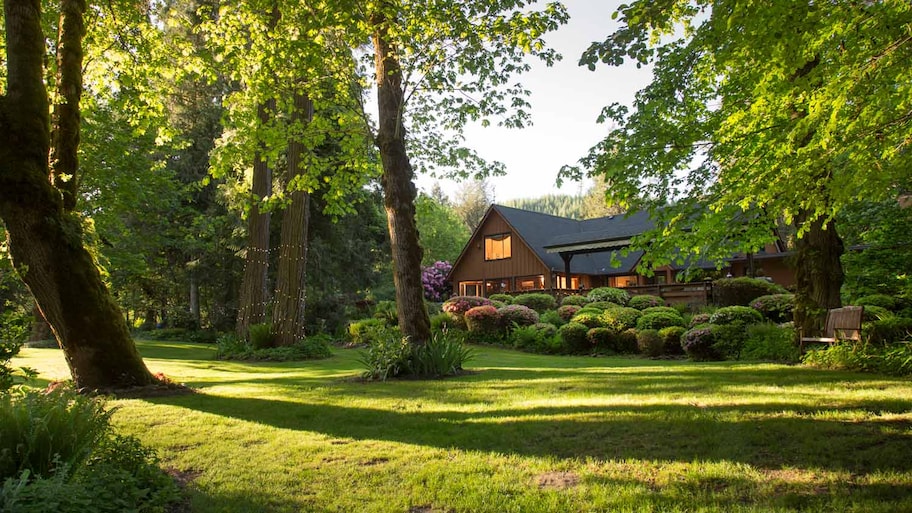How to Plant a Tree You’ll Enjoy for Years to Come
Boost curb appeal (and make the Lorax proud) with a properly planted tree


- Long handle garden spade
- Long handle garden fork
- Garden hose
- Tree
- Tree stake (1/3 the size of your tree’s trunk)
- Tie
- Tree guard
- Mulch
Arbor Day isn’t the only day you can plant a tree. In fact, learning how to plant a tree is an excellent, simple landscaping idea that doesn’t just add a little green to your backyard and block out potentially nosy neighbors.
According to the Arbor Day Foundation, one mature tree can absorb 48 pounds of carbon dioxide per year. In other words, it’s easy on the environment and your eyes—and you can do it on your own in an afternoon. Here’s how and when to plant a tree.
Tree Planning
Proper planning is the most important step in learning how to plant a tree. Choosing the right tree, picking the perfect placement, and ensuring your timing is on point will set you and your tree up for success. Here are the main factors to account for in your tree planning phase.
Picking a Tree
Before planting a tree, consider the size, shape, and watering needs. It will grow, so make sure it’ll fit in your space (or get ready to prune the tree often). Since newly planted trees are fragile, don’t set yourself up for failure.
Native trees (those that naturally appear in your specific climate) have the best chance of surviving without a ton of maintenance. Choose your tree based on your USDA Plant Hardiness Zone.
Northern States
If you’re in zone 6 or 7 (which covers much of New England), you’ll need to choose a tree that can withstand frost. Deciduous trees like oaks and maple can provide fall color but will shed their leaves in the winter. Evergreen trees will stay green year-round.
Southern States
If you’re in a warmer zone, like zone 9 (which covers the most southern parts of the United States), you’ll probably want to choose a drought-tolerant tree that can withstand high temperatures like sycamore, cypress, or ginkgo.
When to Plant a Tree
Early spring is the ideal time to get young saplings in the ground, just before the new buds break for the season. The mild weather and springtime rain will help your new tree develop stronger leaves and roots, allowing it to flourish in the summer sunshine while also standing up to the extreme heat.
If your climate zone experiences intensely hot summers, it’s especially important to get your trees planted earlier in the spring rather than later, as underdeveloped roots may not be able to survive the extreme heat.
Planting trees in fall when they’re soon to be dormant is a good option as well, as it will help prevent heat damage and give them the best opportunity to flourish during the growing season.
For the best results, opt for evergreens and other trees that are adaptable to colder climates. Again, be sure to plant early in the season, just as cooler temperatures arrive.
Tree Placement
When choosing how to plant a tree and where to plant it, location is a crucial factor. Select an area with proper sun and plenty of space for the tree to grow. Account for the tree’s full-grown size and keep it away from overhead electrical lines, underground utility lines, driveways, and sidewalks.
Tree roots can also damage your home’s foundation, so allow plenty of space between the tree and your home, garage, and other structures.
Tree Stress When Planting
Transplant shock can happen when planting a tree, which might cause wilting leaves, early fall colors, dying branches, or even the death of the tree.
To minimize the risk of this happening, plant your tree during spring or fall when the sun is milder—hot, dry summers can do a number on young saplings. It’s also important to ensure your newly planted tree gets plenty of water during the beginning stages.
How to Plant a Tree
Once you’ve selected your new tree, as well as when and where to get it in the ground, planting is a relatively straightforward process.
Here’s how to plant a tree and set it up for years of happy growth.
Dig a Hole
 Photo: Ozgur Coskun / Adobe Stock
Photo: Ozgur Coskun / Adobe StockThe first step to planting a tree is digging the hole. Use your garden spade to dig a hole that’s as deep—but about three times wider—than the tree’s nursery pot. Use your fork to lightly break up the soil around the edges of the hole. If the soil is compacted soil, your tree will struggle to grow.
The depth of your planting hole is very important. One of the most common tree planting mistakes is digging a hole that’s too deep. The top of the root ball should line up with the top of the soil.
Unwrap the Tree
Remove the tree from its nursery pot. Sometimes, a new tree will have a fabric wrapping. Depending on the nursery's instructions, you may or may not need to remove this.
Dampen the Root Ball
Use your garden hose or a bucket to saturate the root ball. Make sure it’s soaked thoroughly before planting.
Spread Out the Roots
Some tree species (like magnolia or eucalyptus) do not like root disturbances. Most of the time, though, you’ll need to unwind and spread out the root ball to encourage the roots to grow into the soil. If your tree is rootbound, you may need to trim the roots to loosen them. You can also cut off damaged roots.
Plant Your Tree
 Photo: zoomingfoto1712 / Adobe Stock
Photo: zoomingfoto1712 / Adobe StockPop your tree in the planting hole and make sure the top of the root ball is level with the soil surface (a piece of wood or your spade’s handle can help you measure).
Fill the Planting Hole
Use your spade to refill the hole with excavated soil. Make sure there aren’t any air pockets, since the roots will die if they’re not in contact with soil. You can pack it down gently with your heel (but don’t press too hard because you don’t want to compact the soil).
Protect Your Tree
Trees can be fragile before they root, so you may want to perform the following tasks:
Stake your tree to protect it from windrock.
Use a tree guard to protect your tree from wildlife.
Stakes are particularly helpful for large, heavy trees. Put your stake into soil at a 45-degree angle and attach your tree’s trunk using a tie.
Water
 Photo: AJ_Watt / Getty Images
Photo: AJ_Watt / Getty ImagesOnce you’ve planted and staked your tree, water thoroughly.
Add Mulch
Mulching the area can help nourish your tree, insulate the roots, and prevent weed growth.
DIY Tree Planting vs. Hiring a Pro
If you know how to plant a tree, it’s not hard to do on your own—but it does get more difficult the bigger you go. Trees larger than 30 feet generally require specialized equipment like a cherry picker. In some areas, you need to apply for a permit.
Even if you can manage the job alone, a tree service in your area can test your soil quality and make sure your trees have the best possible chance to grow. Since watering your tree is important while it roots, you may want to consider hiring a local outdoor watering service, too.
Frequently Asked Questions
Opt for a barefoot tree. Pros harvest barefoot trees when they’re dormant (leafless). They shake the dirt from the root ball and pack it in moist material.
These trees can cost half as much as the trees at your local nursery, and you can buy them online—so there’s a much wider selection. Just make sure you keep your barefoot tree cool until you’re ready to plant it.
If you want to take your tree-planting hobby beyond your outdoor space, here are a few great ways to do it:
Encourage your neighbors to participate in the Arbor Day Foundation’s Tree City USA program, which has a four-step framework that helps communities grow and maintain their own tree cover.
Support businesses that plant trees.
Lobby your local government to plant more trees around your community.
Donate to a tree-planting charity.
First, dig a hole that’s the same depth as the root ball and wide enough for the roots to spread out fully. Before placing the tree in the hole, pour water in to help get rid of any air pockets in the soil.
When filling the hole back in, opt for a 1:1 ratio of organic compost with the soil left over from the ground. Do not use potting soil, fertilizer, or chemicals of any kind, as these can stress out and kill your newly planted tree.




















